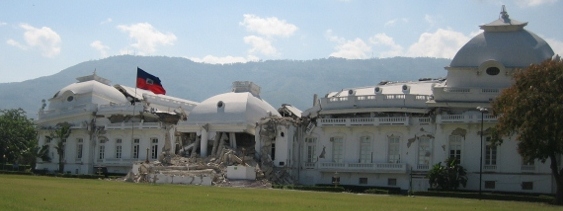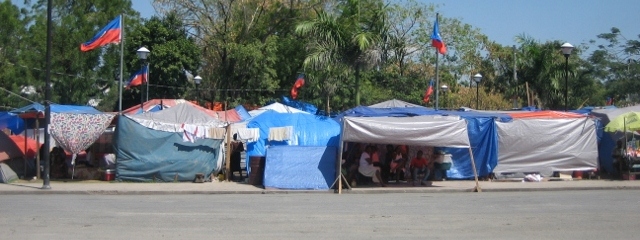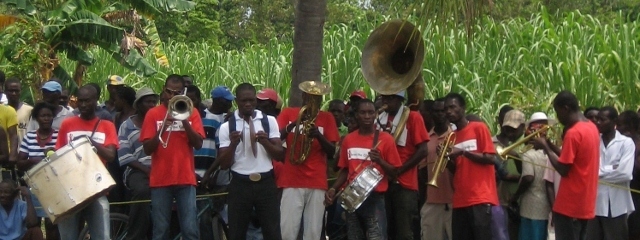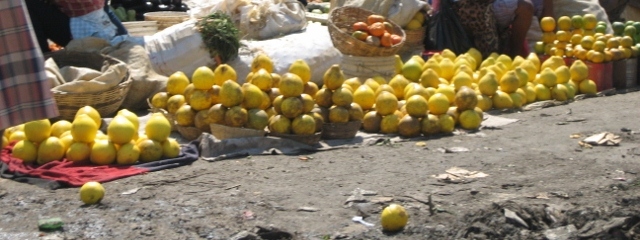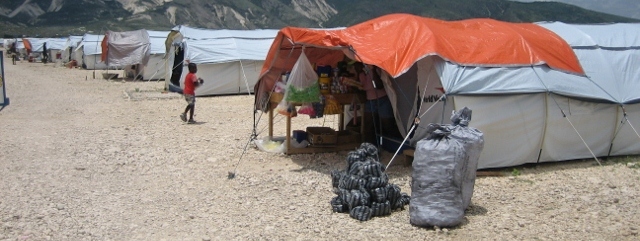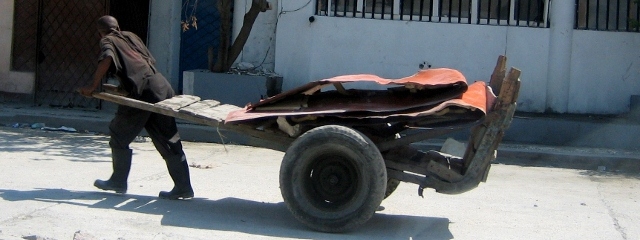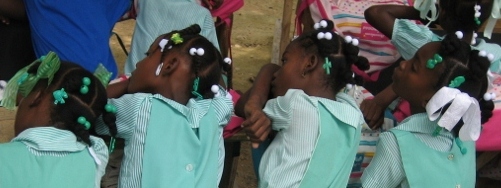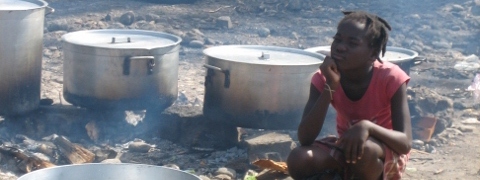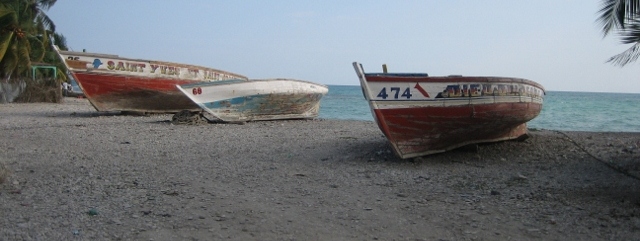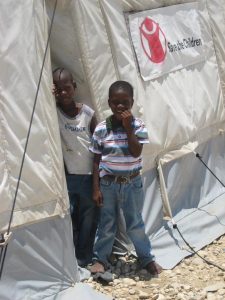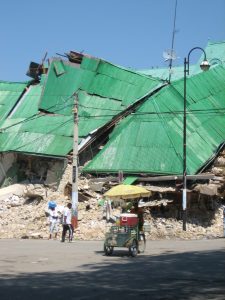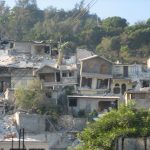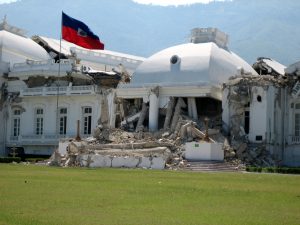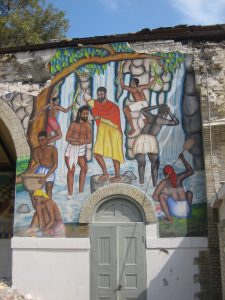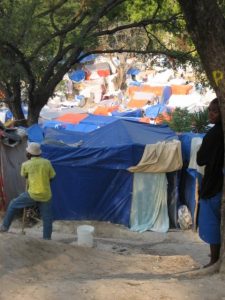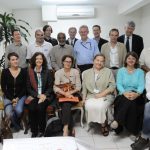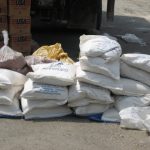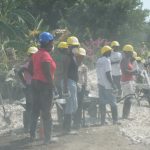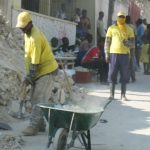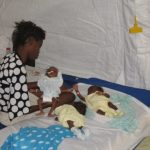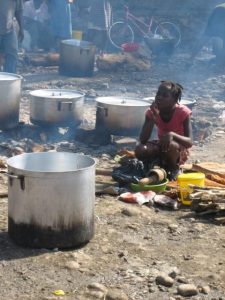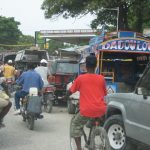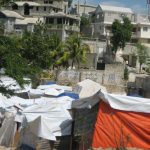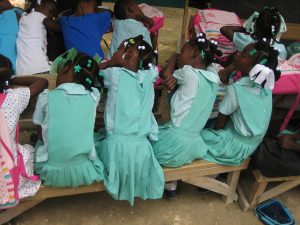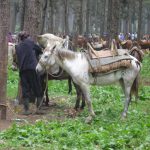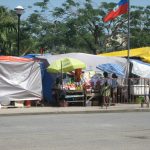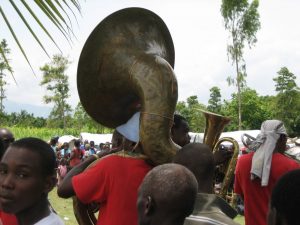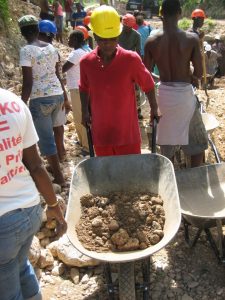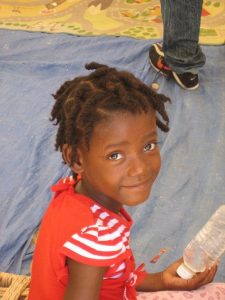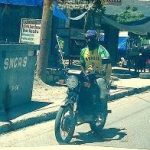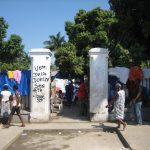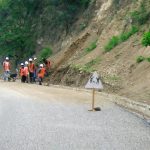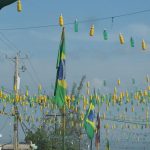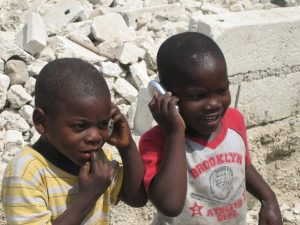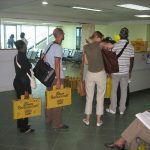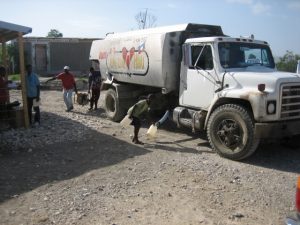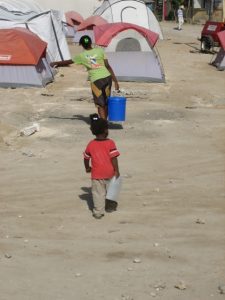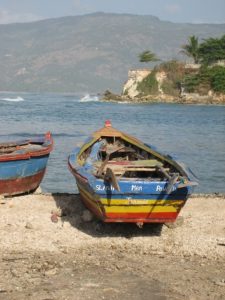This blog doesn’t really fit in a travel website, but then, Haiti is exotic, and part of the content is about travelling after all. Besides, it was my first blog, an experience that set the standard for future travels, that were more leisure-oriented, and ultimately resulted in this ever-growing monster website. But most of it, this blog is a mix of experiences and personal views on progress towards rehabilitation, from a five months spell in Haiti immediately post-earthquake (Feb.-July 2010).
I started my humanitarian carreer 10 years ago in Haiti, where I joined Plan International, a charity that works with some of the poorest children in the world. After a number of other jobs elsewhere, amongst others disaster rehabilitation-related in India and Indonesia, I recently returned to my home country, The Netherlands. Not intending to move again, after 25 years abroad, I nevertheless quickly gave in when Save the Children, which is another child-focussed charity, asked me to join their team in Haiti after the January 12th earthquake. Which is why this blog is called what it is called.
It was originally published on https://oudmayer.blogspot.com/. In Feb. 2020 I transfered it to this website, to have everything under one umbrella.
the idea
It all started the day after the massive earthquake that struck Haiti on 12 January. My wife Sofia and I have lived there for three years, from 2000 to 2003, and we still have a strong emotional band with the place. Read more
the preparations
The responses I have received so far are incredibly nice. Obviously the friends and family are all very encouraging, they never believed in my retirement at 50 anyhow. But what strikes me most is the response of absolute strangers: Read more
the journey
Sunday evening by high speed train from Arnhem to Frankfurt, I fell asleep even before the train pulled out of the station, then finding my way at massive Frankfurt Airport, check in with Condor – an airline for holiday makers, but the only one that flies overnight to Santo Domingo. Small shock at the counter, as I had only a one-way ticket… Read more
Arriving by air to Port-au-Prince immediately shows you what’s in the mind of the people: from above you clearly see a tent or some plastic sheeting next to almost every house, people don’t dare sleeping inside anymore. They don’t know how much their house has been damaged. They don’t know what the next aftershock is going to do to them. But they also will not leave their possessions behind, inside the damaged house, unprotected. Read more
The Save the Children office was a relatively small outfit, on January 11th, this year. With the rapid response to the earthquake of the 12th, the place became quickly totally overwhelmed. Where there were perhaps 150 staff countrywide, with 4-5 senior managers, of whom two were expatriates, now there are some 60 expatriates, all of whom consider themselves a senior manager to some extent; and we are already employing some 450-500 people so far, soon to be ramped up to 900 or more. Read more
the shelters
One of the most pressing problems here is shelter. I already told you that many people live in tents outside their houses, or in small camp areas in their neighbourhood, because the houses have been destroyed, or are badly damaged. Often they are too afraid to go back inside, even if the house looks relatively OK. Read more
the shelters (photos)
I did go out yesterday, and I did take some photos. More about that later, but some of the pictures, posted below, relate to the shelter issues I wrote about a few days ago. See all the pictures
the apartment
Having explained the shelter situation of the earthquake-affected population in Port-au-Prince, perhaps I should also pay some attention in this blog to my own living conditions. As always, some are better off than others. Read more
the aftershock
Yesterday night, at about 1.30, we had another cracking earthquake – the are called aftershocks, because they follow a bigger earhquake, even if they come 6 weeks later, but they are of course also earthquakes in their own right. This one was 4.7 on the Richter scale, not much, but apparently very shallow, and it did shake the entire house, badly. Read more
the city
Long awaited….. I finally went downtown last week, to see what the city looks like now. This is not going to be a pretty picture. Read more
the church
Yesterday I wrote about some of the damage to the cultural heritage of Haiti, and I also mentioned the Holy Trinity Church. This church was built in the 1920s, as an Episcopal church, in the center of Port-au-Prince. What makes the church unique is that in 1950 and 1951 a series of murals were painted by some of Haiti’s greatest ‘first generation’ painters. Read more
the resilience
It is less than 2 months after the earthquake. Everybody living through such an experience would be devastated, no doubt, and so are the Haitians; you notice it when you talk to them about what happened, to a police man who is guarding the totally collapsed Ministry of Economic Affairs, or to the men who are clearing the rubble from another heavily damaged site; you notice it with the driver when you go downtown and see the enormous damage, and he becomes very quiet, talks very softly. Read more
the visits
One of the things one cannot avoid in my line of work is visits from important people from across the organisation. One such visit occurred recently. Read more
the abduction
I was going to write about the restaurants. Last week, with so many visitors, I sampled some of the local eateries again, and it was as if nothing had changed from 10 years ago. No more. The kidnapping of two foreign aid workers last Friday has changed the scene, likely for a while. Read more
the haircut
It was something I didn’t have time to get done before I left: in between getting my tickets sorted out, my last vaccinations, and my critical purchases for survival in Haiti, getting my hair ready for the tropics was simply not a high enough priority at the time. But after a month or so, it really started bothering me. Read more
the golfcourse
The Petionville Club was the country club for the Haitian elite. It had some 6 or 7 tennis courts and a nine-hole golf course, but many of its members were not necessarily playing any sports, were just a member to belong, to be part of the in-crowd. Read more
Today I was invited for breakfast with the president. Really. Somehow, I have only met one president before, in my life, and that was president Bertrand Aristide, also of Haiti, some 8 or 9 years ago. It was a mixed experience, meeting someone so charismatic, yet frighteningly so. President Preval is a different person altogether. Read more.
In one of my previous contributions to the better understanding of Haiti in the aftermath of an earthquake – perhaps I adopt this as a subtitle to my blog – I mentioned distributions, of food and of NFIs. Since you may already have forgotten again what NFIs are, I’ll concentrate on food. Read more
A particularly popular mechanism to stimulate the Haitian economy after the earthquake seems to be cash-for-work. This is an approach, used by many UN agencies and NGOs, to put money into people’s hands by paying them for specific activities. Read more
It has started to rain during the day, occasionally. And the rains during the night have become heavier, with thunder and lightning. The rainy season is slowly creeping upon us. I have indicated several times already that this is going to be another disaster, especially for the people in the camps. Read more
One of the things that still remind everybody daily of the disaster is the large amount of rubble all over town, from collapsed buildings and houses. Read more
the job
So what do I do, actually? How do I contribute to the relief, the recovery, the rehabilitation and the rebuilding of Haiti? As you know, I work for Save the Children, which is one of the biggest NGOs in the world, and an important player in those post-emergency activities listed above. Read more
the ghost town
There are 1.16 mln people living in the spontaneous camps that sprung up around Port-au-Prince after the earthquake, according to the latest registration figures from the UN agencies in Haiti. Just think of that for a moment, 1.16 mln on a total population of perhaps 8-9 mln, that is almost 15%!! Read more
With so much of the attention post-earthquake going to Port-au-Prince one would almost forget that the epicentre was actually some 35 km south, near a place called Leogane, and that a much larger area, stretching all the way to Jacmel at the South coast, has been affected. Read more
The road from Leogane to Jacmel is badly damaged in several places. Now was this road never very good, as it runs through the hills and is subject to frequent landslides, but after the earthquake large cracks have opened in the tarmac. Read more
the R&R
I know, all these acronyms! R&R stands for Rest and Recuperation, is a short holiday for those who have been working 6-7 days a week, long hours, and under difficult circumstances. Typically something you give your employees who work in a post-disaster environment, to avoid burn-out. Read more
It was bound to happen, one day – in fact I remember this from the past, when it happened when the Haitian government didn’t have money to pay the bills. The country is running out of fuel. Read more
the criminals
Much has been made of the fact that the main prison in Port-au-Prince collapsed after the earthquake, which allowed more than 4500 prisoners to escape. Read more
All the time there was something missing in the streets of Port-au-Prince, but I didn’t know what. Now I remember. The schools have opened for the first time since the earthquake. Read more
the apartment (2)
Things have changed somewhat, since I last wrote about my living conditions. Read more
the bad day
It has been one of those days. The outlook was already not good. I had to sack somebody in Leogane, and give somebody else a warning letter, never a nice thing to do. Then I needed to continue to Jacmel to discuss various projects and demands to which I was almost certainly going to say no. How to make yourself really popular in one day. Read more
the break-in
As you know, I share the apartment with Johnny, our Lebanese security adviser. When we were having dinner this evening, he received a call from one of our colleagues living in Petionville, further down the hill from us, that they thought there was somebody in the house, and they also heard footsteps on the roof. Read more
The most pressing issue here at the moment is forced evictions. There have been several instances where IDPs (remember? Internally Displaced People, the people in the camps) have been evicted from the areas where they had set up their tents and tarpaulins. Read more
Last time I wrote about schools I promised to get some better photos, and I had the opportunity to do exactly that when I accompanied a BBC Panorama crew, earlier this week. Read – see! – more
I have written about the shelter situation before, soon after I arrived, because it was one of the most visible results of the earthquake. It still is, and it is incredibly complex. Read more
… So we equipped a heavy-duty 4×4 vehicle, with sat-phone, GPS receiver, extra tires, mosquito nets, plenty of food and water – and a bottle of wine, peanuts and olives for the Saturday evening in a remote village. Read more
Yesterday I hinted at the idea to decongest Port-au-Prince. Out of the roughly 10 million population of Haiti, some 2.5 million were living in the capital, before the earthquake, or so say the official statistics. With 200,000 dead, 600,000 who left, and 1.3 million in camps, that doesn’t leave a lot of people in houses, right now, but that is not my point. The key is that Port-au-Prince was heavily overpopulated. Read more
I have told you about distributions, and how complex they often are, and how we often need military protection to ensure that they are being conducted in an orderly manner. Not anymore. Read more
the demonstrations
I have said it many times in the last few weeks: apart from the rubble in the streets, we the humanitarian community have rehabilitated Haiti to where it was before the earthquake: a dysfunctional state. Read more
In many previous contributions I have talked about the amazing resilience of Haitian business, however small scale it is. Here I have collected a number of examples, of typically Haitian business, and of the type of business that has sprung up since the earthquake. Read more
the recruitment
From a small agency employing some 160 people before the earthquake, Save the Children has changed into what I suspect must be one of the larger employers in the country. By now we have something like over a 1000 people on the payroll, a rapid scale up by all measures. Read more
the big brother
A lot of studies have been carried out, related to Haiti and its post-earthquake situation. It is impossible to follow all of it, but one recent study is so interesting and innovative that I do want to share it here. Read more
the internationals
It has never been easy to find international staff for Haiti, but even less so after the earthquake. Read more
I have written about Cash-for-Work before. The idea is that people who have nothing else to do get a job and earn a little money for two weeks, with which they can go shopping so that they start to replace lost assets whilst at the same time stimulating the economy. In Jacmel we had somebody who thought a little more creatively, and decided that if we are going to pay these people anyhow, we might as well have them do something useful. Read more
Corail is the relocation camp about an hour’s drive north of Port-au-Prince, close to the town of Cabaret. Read – and see – more
the politics
Why is progress so slow in Haiti? I mean, after the earthquake, but in fact the question can also be interpreted in a general sense, like what happened in the past 200 years in this country; the answer is the same: politics. Read more
the clearing
Somebody asked me the other day why the humanitarian community had not collaborated all together to clear the rubble as soon as possible. Here’s why not. Read more
It was bound to come up: the Worldcup. We are talking about football, as in the game played with your foot, soccer thus. Read more
It has been raining a lot, lately, and life in the camps must be miserable right now, more miserable even than before. But something else is happening, too, that makes camp life miserable. Read more
the money
We have all seen the appeals for Haiti, five months ago, and we have all been impressed by the generosity of individual people giving whatever they could spare. Read more
I have been very serious, the last week, so let me change tack a bit, and share one of my funnier photos. If you remember I have been talking in an earlier contribution about concerns regarding the road to Jacmel, which goes through the mountains, and has in places been badly damaged by the earthquake. Read more
One of the pillars of the Haitian Government’s Reconstruction Plan is to develop tourism, the obvious choice for a Caribbean island when it comes to creating jobs and generating revenue in foreign currency. All the others did it already. Read more
Just when the atmosphere around the Worldcup started to approach what it had been eight years ago (and probably four years ago, too), with more and more serious expressions of support in the streets, more and more cars decorated in green and yellow or blue and white, more and more people wearing their favourite’s colours on match days, just when expectations were raised and a final between Brazil and Argentina appeared to become a possibility, the country was hit by another tragedy. Brazil lost in the quarter finals! Read more
After every emergency – humanitarian speak for disaster – there will invariably be the look-back reports, one month on, two months on, three months on, one year on etc. We are busily preparing the six months on, at the moment. Read more
One of the things I noticed in the past five months blogging is that you become very observant, even more so than I usually am. A lot of inspiration comes from the things you see around you, which makes you want to write about. Read – and see – more
the last day
The last day for me in Haiti, that is, the reconstruction work will go on for a long time to come, as long as the international community remains committed to this, and can keep the attention focused on Haiti. Read more
Yesterday I got on a plane Port-au-Prince to Paris, and then on to The Netherlands. One way ticket. Leaving Haiti was just as familiar as arriving was, five months ago. Read more
